#doom is such an interesting aspect to me that is SO compelling aesthetically
Photo

emphasis on MAGE in MAGE of DOOM
(BLOOD) (TIME)
#homestuck#sollux captor#hs#PART THREE??#oh sollux despairing that he wasn't the second one i did#boohoo for him he can suck it#anyways this design was fun to do#doom is such an interesting aspect to me that is SO compelling aesthetically#chris doodles
2K notes
·
View notes
Note
Haha. Kazuya. You understand.
one aspect about them i love
THEM TIDDIES
but fr he has his whole aesthetic on point. and I will say. him face. nice
one aspect i wish more people understood about them
HE'S A TRAGIC CHARACTER. HE'S SOOO DOOMED IN ANY WAY BC CHARACTERS LIKE HIM ARE MEANT TO BE PUT DOWN IN A SATISFYING STORY. HE HAS WINGS AT HIS STRONGEST BC THE MOST DEFINING MOMENT OF HIS LIFE WAS FALLING OFF A CLIFF. HE'S ON TOP OF THE WORLD, THE HIGHEST HE'S EVER BEEN, BUT HE'S NEVER TRULY LEFT THE BOTTOM OF THAT CLIFF. HE'S ALONE UP THERE. HE'S A CONTROL FREAK WHOM YOU NEVER KNOW IF HE IS ACTUALLY FULLY IN CONTROL (IF AT ALL) IF YOU REALLY STOP TO THINK ABOUT IT. HE'S SOOO COMPLEX BUT WE'VE NEVER BEEN ALLOWED TO DWELVE INTO THAT COMPLEXITY. HE'S A REALLY INTERESTING CHARACTER AND I DIE INSIDE WHEN THEY KEEP PUSHING HIM INTO THE "PURE EVIL" BOX WHEN EVEN WHEN HE MADE THOSE CHOICES HE STILL IS NOT!!! I FEEL LIKE AN INSANE PERSON WHEN I SAY THERE IS SMTH SO EXTREMELY COMPELLING ABOUT KAZUYA MISHIMA.
one (or more) headcanon(s) i have about this character
- hes still alive in the tekken:tmp timeline since jun successfully "saved" him, and while the familial situation isnt the best it could be, its still far better than you'd expect with jun and jin
- he doesnt even consider himself fully human anymore but hes truly at his core Just A Guy. take the morning coffee. collect shoes. eat boring food. hes a very plain guy and its hilarious. what does he even do all day, the role of a ceo is to make connections and relationships and hes a shadow ceo. he is so painfully A Man In His Fifties that if you remove the tekken context he could grill a mean steak I know this in my heart, what do japanese dads even do for a bbq equivalent.
- kazumi styled his hair Like That back in the day and so he will wear that hairstyle for life
one character i love seeing them interact with
Apparently in bruce's t6 ending, hes speaking to his superior(?) about a mission well done but it's said he's reporting directly to kazuya, so even if who hes talking to is speaking in english I have to wonder if it was meant to be kaz at one point. Anyway if it is I love the casualness of this interaction.
Also jin! people say theyre tired of the mishima focus but NOT ME bc those dudes only interacted ONCE until t8 finally drops. Anyway their hostility toward each other is sooo obviously fabricated bc if the writers REALLY wanted to get into it, this father&son relationship would be so much more complex than that. Also in the first project x zone, devil kazuya is a boss fight and at one point devil and kazuya are fighting for control and for one (1) second, jin sounds concerned for his dad in the way that he wont be able to kill him while kazuya is himself. fun stuff. Their more neutral interactions as a tag team in pxz2 are a lot of fun too, especially when they team up to tear verbally into heihachi. Anyway like everything about kaz, his relationship with his son isnt explored enough.
one character i wish they would interact with/interact with more
Harada For The Love Of God Don't Fuck Up Kazuya's Interactions With Jun In Tekken 8.
I want to see fucking flashbacks man, how did it fucking happen. They had to have exchanged AT LEAST a couple words before getting to jin's conception and I WANNA KNOW. ITS THE MOST MYSTERIOUS AND INTERESTING RELATIONSHIP IN TEKKEN.
one (or more) headcanon(s) i have that involve them and one other character
I feel like. if you stripped kazuya and jun of status and general opposite moral stances, theyre very very similar. I will wait for official t8 confirmation oh what they thought of the other but I feel they are two side of a same coin. People usually speak of jun making kazuya better but I like the other side of kazuya making jun a bit worse. In a very indulgent way I often wonder what it wouldve been like if they tried at all to make it work long term and I dont think it wouldve been that bad, especially compared to how the previous main mishima relationship ended up.
#kaz also has the privilege of not having been somewhat stained like jin in t6 and heihachi in t7#cause both did disservices to these characters#and yet its so frustrating bc kaz. is just. SITTING THERE.#BAMCO HES READY TO GO HE HAS THINGS TO SAY AND DO AND REPRESENT AND INTROSPECTION TO MAKE#OR BETTER YET BAMCO GIVE HIM HERE I CAN MAKE THE NARRATIVE FOR HIM BETTER. I HAVE IDEAS I HAVE PLANS. KINDA#tagging later#nozomijoestar#ask meme
13 notes
·
View notes
Note
hi jes!! i want to ask you about how you enjoyed the Rings of Power series? i just recently watched it and overall had such a good time!! i really really enjoyed seeing Middle-earth in its prime, before everything fell into the ruins we travel through in the Third Age, i felt like was so cool to see the world at its 'height' you know! i also felt like it had a kinship to the movies in that even though the stories were totally disconnected, i /felt/ like i was in the same world? i think it was mostly the dialogue, the language of the series was so lovely, it felt like Tolkien's words to me. anyway i am really just interested in how you felt when watching it! whether you also enjoyed it or it wasn't quite for you? i remember you said you'd watched it a few months back and i never chased you up about it because i wanted to watch it first lol
hi jamila!!! i miss you friend!!!!! i loved the rings of power as an experience even if i felt like sometimes the plotting and pacing needed some significant work. it was just such a joy to be reimmersed in middle earth and i thought every aspect of the set, cinematography, costuming, etc. was just perfect. i totally agree that it felt aesthetically and tonally consistent with the LOTR movies even though obviously so much has changed (in filmmaking etc) since then and the stories are quite different! i was really relieved by that - i was a bit afraid they would game-of-thrones it and make it significantly Darker and Edgier and Sexier but i felt like they really stayed true to the values of the world & the legacy of the films.
my favorite storylines were the elrond/durin friendship (i didn't totally buy the core conflict there but i LOVED their chemistry as friends/brothers) and the southlands humans storyline, which i thought was such an interesting meditation on like, a people living within the shadow of their ancestors' evil, trying to move beyond it while living with these ever-present reminders of the past (the elves' surveillance/occupation of their lands), and also trying to figure out if you are doomed by the choices others have made before you. it reminded me of that moment in FOTR where arwen tries to tell aragorn that he is not isildur and is not doomed to isildur's fate and aragon is like but doesn't his blood run in my veins? just like that question of, do we get to choose our destinies or are we instruments of fate, fooling ourselves into thinking we're different or stronger or better than the flawed people who came before us, only to discover that we are just as flawed and that our 'choices' are us enacting these storylines that were scripted for us long before we were born. i'm also SO intrigued to discover who the mysterious stranger from the sky is... my brother and i think it might be gandalf but it seems like they'd have to do some reworking of the storylines to make that work. idk! i'm excited to find out.
my handful of criticisms: it felt like they were often dragging out storylines a bit too long or taking us back and forth between storylines too much without much changing since the last time we'd visited those characters. i also think it's still suffering from a bit of a crisis about who its central characters are and what their central conflicts are. galadriel felt like a very interesting, complicated, fully formed character in the beginning episodes to me, but then started to fade a bit into the background as the episodes went on. i loved the southlands storyline characters (especially bronwyn and the elf whose name i forget) but i feel like i don't "know" bronwyn that well - she felt like a secondary character who got briefly elevated to primary character importance but without them doing much backstory work or much fleshing out of her as a person. i'll be interested to see if she has a role beyond the first season. numenor was beautiful to visit and the queen's visions of the destruction of numenor were extremely compelling but again the characters there felt a little two-dimensional to me at times.
i really enjoyed it as a whole though!! i do hope that things sort of pick up a bit in the next season but honestly i would watch four seasons of the slowest plot just to spend more time in middle earth!!
#i love what you said about seeing middle earth at its height too!!#i feel like it drives home a bit more how much the LOTR films are set in a dying world#or an ancient world full of ruins of a more vibrant world#the rings of power
7 notes
·
View notes
Text
B-Squared’s Top 10 Games of 2020
I don’t think it’s an exaggeration to say that having something to distract me from the genuine horrors unleashed during 2020 was vital to staying alive, and for me that means a lot of video games! I played…a lot of games last year, but I spent a lot of time playing older games, so I didn’t get a chance to check out a lot of high-profile games that launched this year. Still, I do want to shine a light on the games that managed to resonate with me even a little bit, that somehow managed to launch this year. So let’s get to it!
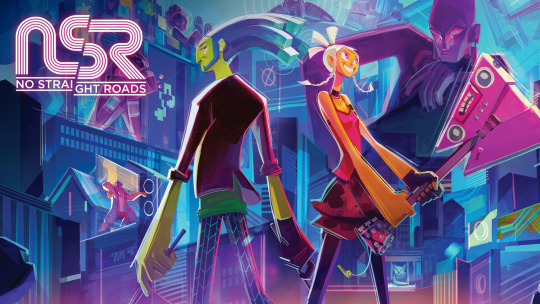
#10 – No Straight Roads
Rarely have I been struck by a single trailer for a game like I was for No Straight Roads. Produced by industry veterans under a new studio, this is a rare game that’s not quite an indie game from a studio full of newbies, but it’s also not produced with the same kind of budget and resources of a Triple-A project. What do we call this? A Double-A game? Single-A? Regardless, I have to give the team at Metronomik some props for delivering a super stylish game in the midst of a very challenging year. No Straight Roads is a rhythm-based action game where two up-and-coming musicians fight to bring back Rock and Roll to the people of Vinyl City. I absolutely adore this game’s presentation, with each major boss being visually unique and having their own feel that compliments the music they bring to battle. There’s some real energy in these animations with character designs that ooze personality, and being a game about music the soundtrack is great! All that being said though, I have to admit I wasn’t a huge fan of the gameplay when all was said and done. It leans way more on the rhythm side of the equation than I was hoping for, and the action felt very shallow. The fixed camera made some phases of some fights a real problem, and the Switch verison, which I played, is plagued with a lot of issues that really brought the game down for me. If the game interests you at all, give it a shot on PC or PS4; I hear those versions are a lot better. Still, I liked the potential I saw in this game and in this studio, so I can only hope they did well enough to continue on. This definitely feels like the kind of passion project that deserves more recognition.

#9 – Streets of Rage 4
OK, so full disclosure: I didn’t grow up with 2D beat-em-ups. I missed out on all of the greats of the genre back in the day. No Final Fight, no River City Ransom, no Double Dragon, and definitely no Streets of Rage. In more recent years I have tried to dip my toe in the genre, as I did in 2019 with River City Girls. However, I came away from that game a bit disappointed by the overall gameplay and wondered if 2D beat-em-ups were for me. Seeing so much praise heaped onto Streets of Rage 4 had me curious, so I knew I had to try it, if only to broaden my experience in the genre. In many ways, this game is the perfect sequel to a franchise that hasn’t seen any signs of new life in years. It retains what made the series beloved with satisfying combat and challenge, but with a modern touch. The overall art style of the game and music work out pretty well, and I found the act of comboing enemies to be really satisfying. It really doesn’t overstay its welcome either, which is very appreciated in an age of endless timesinks. I also struggled a fair bit with the game, even on Normal, and well after some patches that seemed designed for more casual fans like me. Had this game not had online co-op as an option, I don’t know if I could have beaten the final levels. So my time with this game was pretty rough but despite that I can still see this was a game made with care, and if this game DOES do something for you, there’s plenty of reasons to keep playing on higher difficulties, unlocking more characters and even playing online with friends. Let me put it this way; I’m not all that sure I like the genre and I still liked this game, so I think that counts for something!
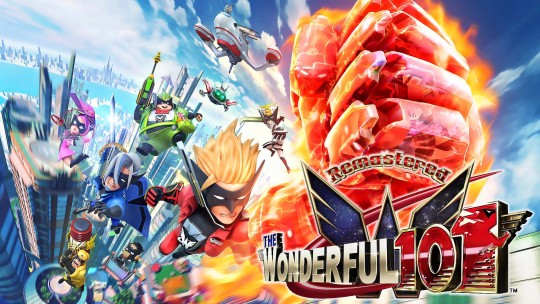
#8 – The Wonderful 101: Remastered
…this one is kind of cheating, I’ll admit! I had a lot of trouble thinking up ten games that really stood out to me this year, honestly. That said, I’ll definitely use loopholes to plug one of my favorite games from years ago. Seven years ago, PlatinumGames launched The Wonderful 101 on the ill-fated Wii U, where it bombed harder than just about anything on the system. For those that gave the game a shot, however, they were quick to discover a deep, complex, and charming action game that plays like nothing else out there. Controlling a team of 100 heroes at once, players form weapons out of the various Wonderful One’s bodies, smacking around giant robots and aliens far larger than them with the power of teamwork! How could you not love that, right?! Now, years later, PlatinumGames is aiming to become more independent and their first act was launching a Kickstarter as a way to get this game on newer platforms. While we may never know why Nintendo gave Platinum their blessing to release this game on non-Nintendo platforms (being as this is still, as far as I know, a Nintendo-owned IP), I’m just glad more people can have access to one of the most unique action games I’ve ever touched.
To sell it another way, this game combines the overall aesthetic of Viewtiful Joe with the shape-drawing action of Okami but with a bit of Bayonetta flair on the side. Basically, this is the culmination of everything director Hideki Kamiya has ever worked on. The Remastered version fixes some issues present from the game’s original release, and while I do think they could have gone a bit further with some changes, it is likely the best way to play the game for many. All those sections that made heavy use of the Wii U GamePad are a tad awkward though, but that held true even back on the Wii U anyway…d-don’t worry so much about that, though! I’d still recommend this game to anyone looking for the type of over-the-top action that only Platinum (and occasionally Capcom) can provide! So please consider joining the Wonderful Ones and Unite Up!

#7 – Paper Mario: The Origami King
Discourse around the Paper Mario series is…more than a little rough, honestly! Many fans have been quite vocal about not liking the direction the series has been heading with the last few games, but I went into The Origami King with an open mind and ended up really enjoying the game for the most part! What the game lacked in a developed storyline, it made up for with some really strong character moments and memorable setpieces. Bobby and Olivia are among my favorite partners in ANY of the Mario RPGs, easily, and the entirety of the Great Sea section of the game was a really fun adventure. I love the highly-detailed paper-crafted enemies and locales, and the soundtrack really didn’t have to go as hard as it did. While the battles against common enemies didn’t quite click with me, the boss battles throughout the game constantly surprised me with interesting twists on the ring-based combat and are a real highlight for me. I know this game is pretty divisive amongst Paper Mario fans, but I think the franchise has a pretty bright future ahead of it!
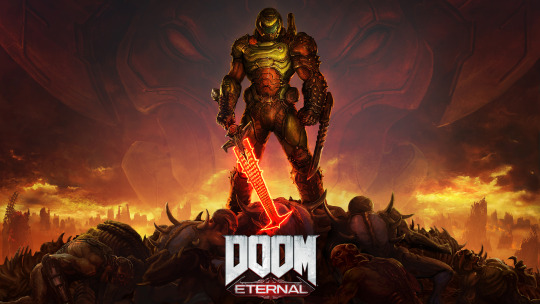
#6 – DOOM Eternal
Fair warning here, but I haven’t quite managed to beat DOOM Eternal at the time of writing this, but what I’ve played so far tells me it definitely belongs here. I think Eternal is hands-down the most intense game I’ve played in a long time. It gets my blood pumping as I dash about, shooting and slicing through demons that are extremely eager to rip and tear me to pieces. I don’t play many shooters in general, so I knew I was going to be in for a rough time, but DOOM Eternal brings it to another level right away. In some respects, I don’t quite agree with various aspects of the core game design that makes the game harder than I think it needs to be at times. The scarcity of ammo, and thus the constant need to use the Chainsaw weapon in order to gain more ammo gets tiring, though that somewhat levels off as more weapons are acquired and players learn of more efficient ways to take out the hordes of Hell. The game’s fantastic soundtrack by Mick Gordon definitely elevates the experience, so it is a huge bummer knowing that he and ID Software had a falling out and he won’t be coming back. I really dig the game’s expansive levels and more focus being put on exploring every nook and cranny for secrets, and certain old-school touches like finding extra lives or cheat codes definitely makes the game feel like it was ripped out of a bygone era and given a modern paintjob at times. Doom is eternal, and with it, so is pulse-pounding shooting action!

#5 – Xenoblade Chronicles: Definitive Edition
Compared to the other re-release of an old game on this list, I think this particular title had a lot more time and care put into it…and it also happens to enhance one of my favorite games on Wii as a bonus! Xenoblade Chronicles on Wii was a game that almost passed me by but even years later, I still adored the characters and world it introduced, and I’ve been happy to see what started as game that was almost stuck in Japan eventually grow into a full franchise. I consider the first game to the best in the series, though it was held back by a few issues later games would iron out. Chief among the problems was the visuals, particularly the character models and…wow does ten years make a world of difference. The Definitive Edition does more than just clean up everyone’s faces, it also cleaned up the game’s cluttered UI, made it easier to track quests and materials for said quests, and added some fun optional challenge missions for veterans to tackle. The bow that adorns the top of this package, however, is the epilogue story Future Connected that serves to tie up some loose ends and gives a particular character some great closure. If you love massive worlds to explore, a compelling, at times over-the-top story, and a deep, rewarding combat system, I can’t recommend THIS version of THIS game enough. If you’re going to give the Xenoblade series a try, there’s no better place to start.

#4 – Ghost of Tsushima
When Ghost of Tsushima was first unveiled years ago, I didn’t exactly have a high opinion of it. It seemed like a game that put more emphasis on visuals over gameplay, and I was almost certain it would launch as a PS5 exclusive so why bother getting excited when I probably wasn’t going to be an early adopter of the system? To my great surprise, not only was this game confirmed for PS4, it wound up being one of the prettiest games on the platform and well-optimized to boot, even on my old slim PS4. Playing as lone samurai Jin Sakai, players try to repel the Mongel invasion of Japan, but are forced to adopt less-than-honorable tactics to take on this ruthless enemy. Usually when I play stealth games, I find myself frustrated. I feel weak, or limited, and often the games feel overly harsh. If you get caught once, game over and there’s little salvaging being seen. In Ghost of Tsushima however, there’s a great deal more care put into stealth, and at times I’d argue it’s almost too fun to pass up over the sword play. Very few missions in the game force you to go completely unseen, so stealth just because yet another tool rather than a limitation imposed on you.
Swordplay felt a bit less engaging against common enemies (typically just being Simon Says, switching to the appropriate stance for a given enemy), but the one-on-one duels throughout the game were fantastic and I almost wish the game was all about them instead. I can’t overstate how gorgeous this game is either, with a world that feels like it is breathing, as the wind whips through the tall grass, the moon penetrates fog overtaking a creepy forest, or seeing the smoke from an enemy camp wafting over the distance. Hands-down one of the best-looking games on the PS4, and I’m particularly happy that developer Sucker Punch managed to land a hit with a new IP, as those generally feel more risky as times go on. While I’d argue that Ghost of Tsushima doesn’t really redefine how open-world games should be designed, it is an extremely polished experience and manages to do it well, with plenty of opportunities to grow in a potential sequel.

#3 – Animal Crossing: New Horizons
If there’s any one game that people absolutely needed in 2020, it was Animal Crossing: New Horizons. While there are other games of this type, like Stardew Valley or the Harvest Moon (and later, Story of Seasons games), Animal Crossing is one of the few games that gets mainstream attention while simultaneously running counter to most mainstream gaming trends. No conflict, no combat, no overarching story really…just a game that lets you live your live, day by day on your own terms. I tried getting into the series before with New Leaf but just didn’t stick with it, but New Horizons launched at the perfect time in an imperfect world. Being able to escape the uncertainty and dread that enveloped the world as the pandemic spread for even a little while was a necessity, and thankfully New Horizons had plenty to do to keep idle hands busy. Changes like item crafting and eventually limited terraforming of your island paradise give players so much more agency in decorating their homes and building up something they can be proud of.
We all start as nothing but a small tent on a mostly-empty island, but seeing what people were able to do even in the first few weeks or so was nothing short of amazing. We need more unflinchingly wholesome games in the world, and I’m thankful for Animal Crossing for being there when we needed it, and considering how well it sold and how much post-launch content is expected to be added with time, it remains a sanctuary to return to even now. Just…please let us craft in bulk? Pretty please, Nintendo?

#2 – Hyrule Warriors: Age of Calamity
Last year, Nintendo released Astral Chain, a game that no one knew about before release, which was revealed and released with very little gaps between them. It was a game I didn’t know I wanted until it was presented to me, and that trend continues this year with Hyrule Warriors: Age of Calamity. The first Hyrule Warriors was a fun, surprising spin-off of the main Legend of Zelda series, and Breath of the Wild was a fantastic game that shook up the core of the Zelda franchise, so in hindsight it really does seem like a no-brainer to combine the two into one package. Age of Calamity, for my tastes at least, cuts down on the repetition and overall stressful atmosphere of the first Hyrule Warriors and instead focused on fleshing out it’s core combat and crafting more creative main storyline missions. It helps that the game reimagines iconic locales from Breath of the Wild from before their destruction, and really makes you feel like you’re fighting through actual places rather than just a collection of random keeps that most Warriors games use.
Bringing in aspects like the Sheikiah Slate and Elemental Rods allows players to control the flow of combat more directly on top of letting them be more creative. Freeze enemies standing over water with the Cryonis rune or burn some grass with the Fire Rod to distract certain enemies, among many other things. Each playable character is also very distinct, even in cases where I could have forgiven the developers for reusing some attacks or traits. For one, Link has different movesets for his Sword and Shield, Spear, and Two-Handed weapons, but none of his attack overlap with the other Champions who use similar weapons. Some people might be put off with certain aspects of this game’s story and ultimately not everyone likes the overall structure of the Warriors spinoffs anyway, but for my part, Age of Calamity was one of the best surprises of the year, unveiled right at the end of the year in the nick of time. Of course, there was one game this year that surprised me more than any other.
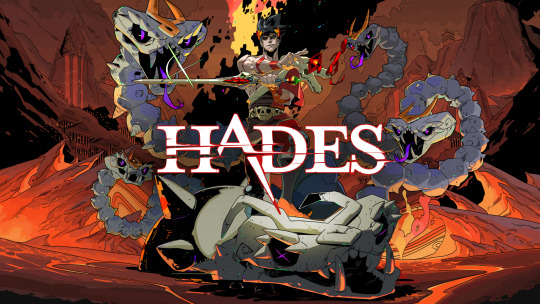
#1 – Hades
I’ve known of Supergiant Games for quite a while and very recently began looking through their catalogue of games. They’re known for well-crafted narratives and satisfying combat, and yet when I first saw Hades when it was released in Early Access I was tepid on it. It didn’t look bad or anything, but it didn’t exactly blow me away and even now, I think a random screenshot or quick clip of the game might not do the game justice in explaining the appeal. I already wrote about the game at-length (as my only real non-retrospective blog post of the year, oops!), which you can read here if you want more in-depth praise, but to summarize…Hades is the total package for me.
Playing as Prince Zagreus your end-goal is to escape the puts of Hell, and more specifically get away from your overbearing father, Hades. It’s a rogue-lite, meaning you’re expected to finish the game in one shot and if you die you lose any upgrades you picked up along the way and have to start from scratch…to a point. Hades does allow you to keep a fair amount of items you pick up which can towards small, permanent upgrades or even gifts for various NPCs that can deepen your bond with them. Unlike most other games of this type too, the story constantly moves forward, even after death. The game is about dying over and over and then dusting yourself off to try again, all the while other characters remark on your progress or lack thereof. I grew to really enjoy this cast of characters, a fun spin on the Greek pantheon, paired with excellent voice acting for the entire cast. From the imposing, if somewhat sultry Megaera, to the nervous wreck that is the maid, Dusa, to the pompous ass Theseus, I looked forward to each new run just to learn more about this world and those within it. For once, death wasn’t really a punishment, but a reward, and just part of the process.
Of course, incredibly satisfying combat is ALSO part of the process and it just gets…addicting; muttering “one more run” over and over as you try out different weapons and boons, discovering what works well together and what doesn’t. While at first beating the game felt like it would never happen, I grew from my failures, adapted and eventually overcame. Multiple times. If you want the “full” Hades experience, this game can really demand a lot of time out of you but at the same time it stays fresh, so I can’t really complain. With new gameplay mechanics unlocking as time goes on, to the Pacts of Punishment players can trigger if they want a bit more challenge (or a lot more), Hades is that rare game that just keeps giving and giving. Before I knew it, I had dumped well over 50 hours into it, and I STILL need to get back to the game if I want that epilogue.
Compared to every other game that came out this year, Hades is the one game that grabbed me from moment one and would not let go until I hit credits. When I wasn’t playing this game, I was counting down the minutes until I could play it again, and let me tell you that is rare for me these days. At this point, Hades is clearly the breakthrough hit for Supergiant and I couldn’t be happier. The fact that this game got to stand shoulder-to-shoulder with industry titans at The Game Awards is kind of surreal, but I can’t think of many who deserve that recognition more. It helps that Supergiant is a studio that actually takes care of its employees, which is way rarer than it should be. I don’t mean to hype this game up like it’s the cure for COVID or anything, but I mean it with all my heart that this was the best game I played this year, and I’d recommend it in a heartbeat. I couldn’t stop talking about it for months after playing it, just ask my friends! So yeah, it’s pretty OK I guess.
CONCLUSION
I’m sure my Top 10 List looks a lot different from most out there, but that’s what’s great about games! So much variety and so much quality no matter where you look! Every year, without fail, there’s always at least a small handful of games that come out that I don’t get to, and try as I might I’ll never trim that backlog down. I want to keep playing games for as long as I can, trying out so many different experiences and seeing what this wonderful pastime can offer. For a good chunk of 2020 I was more than a little down, not just because of…you know, but a lot of games that were coming out weren’t appealing to me. That said, seeing as this was the year of shadow drops and announcing things at the last minute, I ended up loving a bunch of games I hadn’t already spend months hyping myself up for, which definitely helped to lift me up this year. Already, 2021 has a lot of titles I’m anticipating though, so it’s sure to be an exciting year.
Happy Gaming.
-B
#top ten list#gaming#animal crossing#paper mario#xenoblade chronicles#ghost of tsushima#doom eternal#no straight roads#hades#streets of rage 4#thewonderful101#age of calamity
2 notes
·
View notes
Text
Dialectic Identity? Thoughts on Fozzer, the Page of Heart:
OK this is gonna be shorter than Marvus obvs but Fozzer DID give me a good amount to think about, so here goes
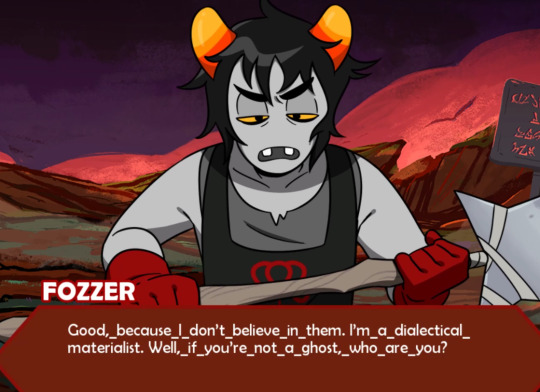
Fozzer outright identifying as a dialectical materialist is exciting for a couple reasons. There’s a lot one could say about dialectics and Paradox Space in general (I’ve been trying to write that script for about a year) but here I want to focus on the Materialist half of that, because it immediately reminded me a lot of @arrghus’ idea of the notional/material divide between aspects.
Ever since the Extended Zodiac, we’ve been wondering if the way the Aspect wheel is laid out might suggest some relationships between Aspects, either original to Homestuck, mirroring the relationships the Signs share in the traditional Zodiac wheel, or some combination of both.
Arrghus’ essay series proposes a model for how those relationships might work, at least in part. I’d suggest checking it out for the full picture, but here I want to focus on the divide I find clearest and most compelling: That between the Ideal/Notional Aspects and the Material/Physical ones.

The gist is this: The top five Aspects (Mind, Hope, Breath, Life, and Light) are more closely aligned with the World of Ideas, and so those bound to them tend to be more concerned with the ideal, abstract, and imaginary. The bottom five (Void, Doom, Blood, Rage, and Heart) are more closely tied to the material, physical, and real.
If you’ve seen my prior writing on Homestuck, you might note that this dovetails easily with Gnosticism’s old cosmology of reality as divided between an imaginary world of Light and a physical world of Darkness. That said, this isn’t a hard binary--Blood obviously refers to some concepts as well as physical experience, and Breath obviously links to some things that happen in physicality, even if those elements are by definition elusive and insubstantial.
Space and Time are an even split, as much conceptual law to be deciphered as they are physical element of reality to be experienced. It could well be that this reflects most strongly in the perspectives those Bound to each Aspect are given to, as opposed to an underlying reality of the Aspects themselves, and in any case all twelve Aspects are necessary to describe a full picture of reality.
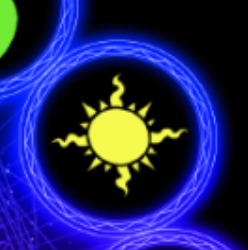
One of the most exciting possibilities this model raises for me is the idea of Aspect “Mirroring”, which is essentially a different kind of relationship Aspects can have. Aspects that are Mirror each other vertically, for example, might express the same ideas through the filter of the Ideal vs. the Material--reflecting the hermetic/magical principle of “As above, so below”.
Heart and Light are a pretty good way to express the relationship between vertically mirrored Aspects, as it turns out. Consider:
In Gnosticism, “Light” refers to directly to Information/Ideas, as the world of Light is the world of the imaginary. This is where “Platonic Ideals” live--the perfect imaginary version of any object, from which all physical manifestations of that object are derived.
Humanity gains the ability to access this world, the self-aware conciousness necessary to think, when the Goddess of Wisdom Sophia descends from that realm and imbues us with her Light--the light of curiosity, of wisdom, of the power to know. The light of the soul.
In this way, we can think of the Soul--the Heart--of living beings as their inner Light, expressed throughout their lives in the realm of physicality. And we can think of Light/Ideas as abstract concepts, that can only enter reality proper through the doorways created by the self-expression of individuals, as enabled by their soul.

There are a lot of ideas and concepts that Dirk’s soul seems consistently inclined to express onto reality. The shades, the concept of “being a Bro”, the idea of the Hard Anime Dude, Stoicism, the pervasive homoeroticism innate to the Greek ideals he’s generally shaped by, etc.
The clearest example of this might be his sword, which is itself a physical object seemingly ripped directly out of the “fake” (read: imaginary) world of anime. An idea, made physical, through the sheer expression of will manifested by Dirk’s soul.
This is what makes his katana so powerful:
It’s quite near to being a physical expression of our collective idea of the “Perfect Sword”, much like Bro sets an impossible ideal of “Perfect Manhood” that Dave wrestles with living up to. This might give you an idea of some of the more direct ways Heart’s conceptual toolbox could be exploited or weaponized.
The point here is that just expressing the idea of a “Bro” is extremely important to Dirk, and expressing the idea of “Cats” is similarly important to Nepeta and Meulin.

In the same way, Fozzer seems like an acutely intense expression of a political Persona. A philosophical idea, expressed in the physical world as an intense commitment to an associated identity. His shovel is an expression of that identity, much the same way Dirk’s katana or Nepeta’s claws are expressions of theirs.
But then again, Fozzer’s identity ain’t exactly stable, is it?
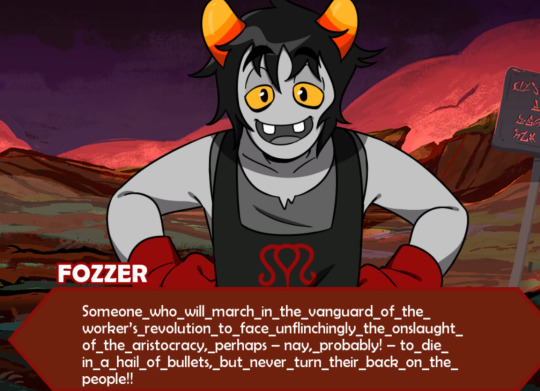
Before we talk about The Thing That Happens, we should note that as much as Fozzer seems to genuinely believe in his communist philosophy, he mostly seems interested in it as a means for self-expression, rather than an actual political movement with direct goals and results he’s looking to achieve.
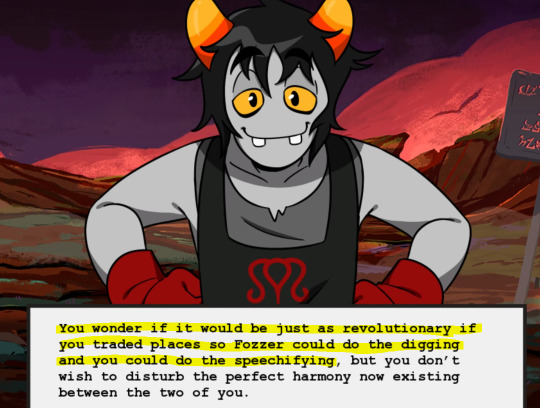
And even though he’s very intense and earnest about it, Fozzer seems inclined to exploit his own identity in somewhat self-serving ways. Unintentionally or no, he more or less uses his ideological speechifying to conscript the Reader into doing work for him, therefore inviting the reader to Serve him through Heart, for Fozzer’s own benefit.

This, coupled with his strongly noted cowardice, leads me to consider him a Page. But my real point here is that even if a lot of us here on Tumblr find Fozzer’s ideology appealing, Fozzer seems less invested in ideology proper than with the identity it comes with--and even here, Fozzer isn’t exactly being portrayed as unambiguously Good and Correct.
Even if he’s preferable to the alternative. Sigh.
Let’s talk about the thing.

[WORLDBUILDING INTERMISSION]
So the biggest surprise of this friendsim was that we stumbled onto what’s basically a swell of Scratch energy just...hanging out under Absence Park, apparently?
Which is. A lot. This energy resets our conversation with Fozzer and changes his personality, which we’ll get into in a minute, but first I want to speculate:
How the hell does this thing exist at all, and what does it even mean? There’s a couple of possibilities.
Since this is essentially Time-coded Scratch energy we’re dealing with, @blindrapture pointed out that it could have something to do with the Handmaid, which I’d expand to include Lord English--and though I doubt it’s directly linked to Scratch himself, since he’s not too associated with Time the way the former two are, he may be aware of or able to use this...”glitch” in reality.
It’s also possible this is a natural consequence of a Scratch, and pockets of leftover Scratch energy like these are present in some locations of Post-Scratch worlds. For that matter, it could be a consequence of John’s retcon powers, which act like the scratch in some ways and might have had consequences we don’t yet fully understand.

Finally, given the language, I suspect that the hole in Absence Park is actually just a hole into the Void, leading to the Furthest Ring, much like Roxy’s windows. This Scratch energy seems to have entered the Furthest Ring, and is presumably writhing there until circumstances allow it to vent out through this particular entrance to reality.
What are the implications? Who knows. If this is a hole into the Void, then this is another avenue through which Hiveswap’s cast might be able to exit Alternia and find a new world.
If the Scratch outbursts are recurring enough, then we have at least one way for our heroes to “Time Travel” and basically save scum to try and achieve optimal desires results, like saving a troll friend who gets killed by going back in time for example.
That’s probably the biggest takeaway to me, because having a way to time travel built into Hiveswap’s text already makes me that much more sure that no matter what kind of carnage and brutality our beloved troll friends get subjected to, we’re ultimately headed towards a happy ending where probably nobody dies--
I can reasonably see the possibility that even antagonistic figures like Ardata and even Trizza could be saved, under these circumstances.
Ok back to Fozzer.
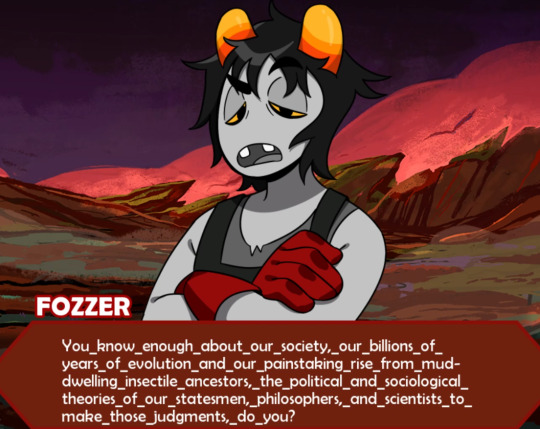
So the thing about “Post-Scratch” Fozzer is that I feel he’s being dismissed somewhat due to his admittedly unsavory politics. This still strikes me as a very genuine and direct expression of Fozzer’s Classpect inclinations.
Fozzer is still taking a very materialist view of reality here, for example--he’s interested in the actual physical history of how this system evolved, and considers understanding that history necessary to understanding society.
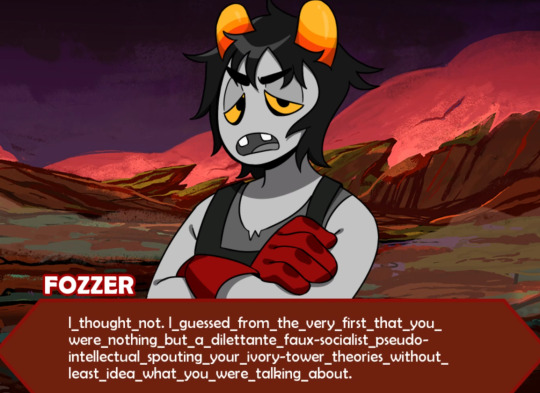
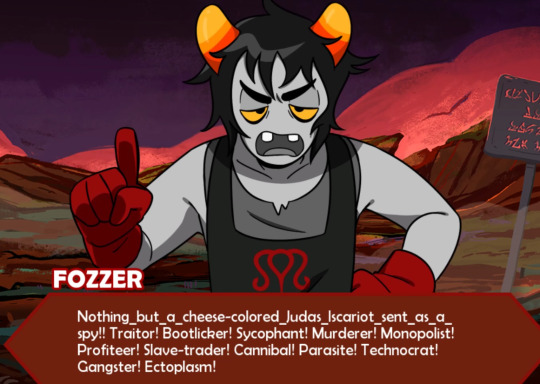
And however he disagrees with you, his instinctual response is the same. He storms off after verbally thrashing the Reader, but its interesting that he does it the same way both times: By imposing identities onto the Reader. Hilariously, Fozzer is unwittingly owning alternate versions of himself, too, and unwittingly inviting self-owns is basically the core of the Knight/Page aesthetic.
So really, Fozzer’s core personality is much the same--what’s taken place is a binary flip in the persona he relates to the world with. In one reality, he conveys the ideas of the hopeful revolutionary underclass.
In the other, he projects the identity of a happy and willing member for the Empire’s war-machine--the joyful slave, the pain of his own exploitation cushioned by a strong sense of societal purpose and identity. Note how the shovel easily parses as a strong symbol of this identity, too--a triumphant tool with which to serve the empire, rather than an ironic symbol of oppression.
I don’t think we should be hasty in assuming one Fozzer is more real than the other, even if we’re inclined to like one of them more. Especially since Fozzer works in Absence Park and seems familiar with these lights, meaning these scratch shifts might have been happening to him for a while.
The two Fozzers give us a fascinating window into the nuances of Heart, and indeed we’ve been told this sort of splintering of self can be common to the Heartbound by Calliope. Their opposing ideologies present us with a self-contained dialectic, in fact.
A dialectic at its core is a search for truth carried out by contrasting and comparing two diametrically opposed ideas, which in Hegel’s dialetic at least are defined as the Thesis and Anti-Thesis, respectively.
In Hegel’s understanding of the term, we can only truly understand an individual idea (say: Fozzer) by examining the tensions and similarities between these two opposed perspectives.
And these tensions are usually resolved not by one winning out over the other, but by achieving a Synthesis that combines he best traits of both.

Maybe because of that, I find the fact that we can only “win” by embracing the “Happy Slave” Fozzer unnerving. It’s hard to say how Fozzer’s path will evolve going forward, but given how central the idea of conflicting opposites is to his expression of his Classpect, I highly doubt we’ve seen the last of “Comrade” Fozzer.
So, I guess we’ll just have to see how it goes?
[Closing disclaimer: I’m not entirely sure how different Marxism’s Dialectic Materialist approach is from Hegel’s Dialectics. For instance, I’m unsure if it also uses the “Thesis”, “Anti-Thesis”, “Synthesis” model Hegel describes, or if I’m accidentally mixing the two.
@gamblignant8 on the Perfectly Generic Podcast described Dialectic Materialism as being Hegel’s Dialectic applied with a focus on physical reality, mixed with an analysis of humanity’s historical evolution on the physical plain.
Cursory Wikipedia research seems to bear this out, with Marx even describing Dialectic Materialism as simply the opposite of Hegel’s more philosophical and idealistic take on the idea, which Marx regarded as full of “Mysticism”. As a Hopebound more comfortable with the ideal than the material myself, I suppose its no surprise I find Hegel’s dialectics more immediately approachable and comfortable, for now.
What I’m saying here is, take everything I’ve written about dialectic materialism here with a grain of salt: I’m trying to do my homework and make sure I have the facts straight, but it turns out philosophy can get hard to sum up, especially when you’re trying to reconcile it with a fantasy metaphysics system. Feel free to clarify if I’ve messed details up. ]
#Homestuck#fozzer velyes#fozzer#Hiveswap#Hiveswap Friendsim#My MSPA Analysis#Gnosticism#Heart#Light#Persona#Dialectics#Dialectic Materialism
216 notes
·
View notes
Text
2018 is over and I feel compelled to write a retrospective of sorts, but since I don’t feel like talking about myself I’m gonna talk about Every Anime (Series) I Watched in 2018. Each one comes with a numerical rating out of 10 and a short blurb of what I thought about it.
Recovery of an MMO Junkie - 9/10 - Incredibly sweet and heartfelt, with mature adult characters who act as such. Drama and comedy both are mined from real issues rather than petty miscommunication, and is all the more compelling for it.
Land of the Lustrous - 10/10 - A delightfully unique setting with an enrapturing story and fantastically constructed characters. The moments of levity and sweetness only serve to make the deeply engrained sadness and loneliness more poignant. The CGI animation is shockingly gorgeous, and a triumph of the medium.
Kino’s Journey: The Beautiful World (2018) - 5/10 - Certainly entertaining in spots, but ultimately rings rather hollow. Not really an improvement on the original in any respect.
Princess Principal - 8/10 - An absolutely gorgeous setting brimming with atmosphere and style, and a fun ensemble cast. The series-wide arc is a little hard to follow or understand, but each individual episodic plot is really enjoyable and engaging.
The Vision of Escaflowne - 8/10 - A well-built fantasy that’s occasionally ridiculous but never not fun. The new dub is really slick and helps the series go down nice and smooth.
A Place Further Than the Universe - 10/10 - Extraordinarily sweet, earnest and heartfelt. Deftly written, smartly directed, and masterfully executed. I cried really hard, a lot.
Tsuredure Children - 8/10 - Cute, ridiculous, and eminently relatable. If you’ve ever had a crush, you’re bound to identify with at least one character in this series.
From the New World - 5/10 - Had a glimmer of potential, but mostly ended up fake deep, poorly paced, and fucking ugly to look at. The more I thought about this series the less I realized I enjoyed it.
The Ancient Magus’ Bride - 5/10 - An extraordinarily promising start that’s disappointingly squandered by wildly inconsistent tone, static plots, nonsensical character arcs, excessive cliffhangers, and hollow stakes.
Princess Tutu - 10/10 - An expertly built deconstruction of fairy tales as well as a sweeping, gorgeous love note to ballet, classical music, and romantic storybook heroism. Wonderfully intricate plotting and stunning character work, a true gem.
Kaiba - 8/10 - Brilliantly unique and emotionally engrossing, if not a bit obscure and hard to follow at times. You never have, and probably never will again, see an anime quite like this.
Girls’ Last Tour - 7/10 - Deeply atmospheric and sometimes quite poignant, but also dreadfully, awfully, agonizingly slow.
Haven’t You Heard? I’m Sakamoto - 9/10 - A smooth and even mix between laughable absurdity and actual real emotional stakes. Somehow, I feel like I learned something about myself.
Megalobox - 8/10 - Briskly paced and action-packed, but by far the biggest draw is a classic 90s aesthetic reminiscent of pre-digital legends like Cowboy Bebop. This series lives and breathes style.
Legend of the Galactic Heroes: Die Neue These - 6/10 - Would have the potential to be interesting if it wasn’t so hollow and boring. I wanted to get more engaged in the politics of this complicated war, but the plot is held at arms length and the characters are more like walking philosophy textbooks than actual people. That said, the ship designs are pretty cool.
Hinamatsuri - 10/10 - Sweet, pure-hearted, and gut-bustingly funny. Any moment I wasn’t laughing until my sides hurt, I was near to tearing up from actually caring about these characters so much. Each episode was a joy and I loved every second of it.
Golden Kamuy (S1) - 7/10 - Absurd, charming, and goofy, with a surprising amount of gore. Seems to care more about food than plot, but I’m kind of into it.
Revolutionary Girl Utena - 9/10 - Brilliantly dense, symbolic, and metaphorical. Sometimes hard to understand, sometimes hard to watch, but always excellent.
Dragon Pilot: Hisone & Masotan - 7/10 - Gorgeously animated and undeniably charming, but still a little awkward, garbled, and uncomfortable at times. The most earnest vore anime I’ve ever watched.
Steins;Gate 0 - 4/10 - A total, utter, crushing disappointment. Follows up a spectacular prequel with a nonsensical, contrived plot, inaccurate characters, and piss-poor visuals. This series is only carried by its relationship to the original. I will never trust again.
Princess Jellyfish - 7/10 - Charming, varied characters populating an unfulfilling narrative.
The Big O - 6/10 - Plenty of goofy, stylish fun, but slowly devolves into an inscrutable, incomprehensible mess. R. Dorothy Wayneright is the best part of this series by far. Roger Smith is a louse.
Aggretsuko - 7/10 - Fun and relatable, if a bit simple.
TOP 3
3. Hinamatsuri - This series came totally out of left field for me. I usually don’t emotionally respond to comedies very well but this one somehow hit all the right buttons. None of the humor was mean-spirited or put anyone down, the situations were absurd but didn’t cripple me with secondhand embarrassment, and on top of it all I really started to care about the cast. I wish I could get surprised like this more often.
2. Land of the Lustrous - As you can tell if you’ve been following me at all recently, this series has been absolutely consuming me from the moment I watched it. The plot is gripping and excellently paced, and I don’t know if I’ve ever been invested in another main character quite as much as Phos. It’s plenty easy to get wrapped up in thinking about the plot and the character arcs and the meta, but then when I go back and watch the series again I’m shocked by how good it is on a technical level, too. The CG animation is beyond gorgeous and the technical grace of each scene, the pacing, the colors, the music, the character animation, the voice acting, are all stellar. If this anime had more of an ending it would absolutely be my number 1 pick, but for now I just have to read the manga (AS SHOULD YOU, YOU COWARDS. IT’S EVERY BIT AS GOOD AS THE ANIME).
1. Princess Tutu - I, like many people, I think, reacted with derision at the title of this series, but by the time I was done I was completely blown away, and every time I thought about it more I was even more shocked. Every inch of this series shows some of the smartest construction I’ve ever seen in fiction, every layer is filled with stylistic flourish, brilliant writing, and metatextual commentary. You can dig as deep as you want and Princess Tutu will always have something to offer you. It’s been less than a year, I’ve already watched it twice, and I’m still discovering new things about it. A story this brilliant would be a once in a lifetime experience on its own, but Tutu is fulfilling on the surface level, too. Even if you’re not diving deep into what the series means you can still be just as enraptured by the characters. Fakir probably has the best redemption arc this side of Prince Zuko, and I could sing the praises of every other major cast member. And the music, the music! I was doomed from the start the moment I heard both The Nutcracker and Pictures at an Exhibition in the score. Princess Tutu takes some of the greatest masterpieces of western art music and builds off them, creating a sense of atmosphere as deep and vast and dramatic as the finest opera or ballet could ever be. Princess Tutu is one of the greatest works of fiction I’ve ever consumed, and absolutely the best I’ve watched this year.
BOTTOM THREE
3. From the New World - Immediately after I stopped watching this series I actually sort of thought I’d liked it, and I think the reason for this is because From the New World tries its very best to engage in ideas a bit deeper and more ambiguous than a lot of other anime do. But the more I thought about it, the more I disliked this series. Everything about the plot was confusing and off-putting, I didn’t find the characters particularly charming, and perhaps most of all, this series is butt-ugly. It might have a high score of MAL. but my advice is to give this series a hard pass.
2. The Ancient Magus’ Bride - I wanted to like this series so fucking bad. I fell in love with the prequel OVA and waited anxiously for each new installment to come out. I even bought tickets to my local Artsy Fartsy Theater to see the first three episodes when the screened there. And I liked them! Finally, an anime engaged in Celtic and English mythology, some of my favorites, and a protagonist with a truly gripping internal struggle. I was certain from the very first moment that this series would sit in my Top 10 list, and that Chise would be one of my favorite protagonists ever. And then it... didn’t happen. As the episodes unfolded I was treated to a series that had no idea how to establish or maintain stakes, how to relate its two main characters to each other, or how to use the wealth of mythology it was referencing and drawing from. How am I supposed to care when Chise gets stabbed in the chest every 2 episodes and then just kind of shrugs it off for the sake of drama? How am I supposed to be interested in the mythology when it’s all just watered-down fantasy archetypes with giant boobs? Don’t even get me started on the main villain. I feel very betrayed by this series and honestly I’m still bitter.
1. Steins;Gate 0 - This series is as much a lesson in betrayal as Ancient Magus’ Bride, but I think this one stings worse because it’s preceded by Steins;Gate, and anime I love dearly. I sincerely believe that the original Steins;Gate is one of the best anime ever produced, and this sequel struggles to live up to even a single aspect of it. As it began I was hopeful- I liked the darker tone, I liked the idea of a story within a failed timeline. But as I kept watching, I realized something awful: I was bored. All of the charm and intrigue was gone. The characters were all acting different, all looked different (why are all the girls wearing skintight winter coats? Why have their chests all inflated three sizes??), and there was no impetus for the plot. Steins;Gate was driven by simple goals; in the first half, it was to build a time-leap machine. In the second half, it was to save Mayuri. In Steins;Gate 0 the impetus is to... watch Okabe be sad. Hope he gets less sad. There’s nothing to keep the plot moving, and this listlessness was so overwhelming that the random bits of unforeshadowed action and unprecedented (for this franchise) violence felt cheap and confusing after the doldrums we just sat through. By the time the plot finally, finally, picks up towards the final quarter of the series, the damage is done. I don’t care anymore, I can’t figure out what’s going on, and I’m just so done with a franchise I used to love. One day I’ll go back and rewatch the original Steins;Gate and remind myself why I cared so much, but for now I’m nursing wounds. If you say the name “Kagari” in my presence, I’ll probably blitz the fuck out.
Here’s to a good 2019!
12 notes
·
View notes
Text
Assassin’s Creed Valhalla Review
https://ift.tt/3plyw92
Despite releasing 12 Assassin’s Creed installments since 2007, Ubisoft is still finding ways to keep the series fresh, and the latest sequel, Valhalla is one of the best titles yet. Is it a revelation for the series? No—there are very few new ideas presented here. But it’s a polished title with solid gameplay and a story that is exceedingly coherent for an open-world AAA title.
In Assassin’s Creed Valhalla, you play as Eivor, a fearsome Viking in 873 AD who lost her parents in battle, a moment that left her literally scarred and hellbent on getting revenge against the warlord who slaughtered them. It’s important to note that the game gives you the choice to play as a male or female version of Eivor at the start of the game, but you’re also given a third option that allows the Animus to “choose” the gender for you based on the memory being recollected. Theoretically, the game is then supposed to switch between male and female throughout the adventure, but despite letting the Animus choose, I remained female for most of my play time.
After an hours-long intro that sees you exploring and kicking ass across the mountainous terrain of Norway, Eivor and her brother Sigurd set out on a longship to start a new settlement of their own in England, where a majority of the game takes place. The game’s story is as violent and unflinching as you’d expect considering the milieu. Eivor and her crew of Vikings go to war with other clans, and she of course carries out missions on her own in traditional Assassin’s Creed fashion. The game centers on you expanding your clan’s influence across England’s four kingdoms, forging alliances and collecting resources to build up your riverside settlement.
“Collecting” is a kind word for what you’re actually doing—Eivor and her clan are brutal warriors who raid any settlement they come across, pillaging and annihilating their way to land dominance. As you travel the English channels in your longship, with a simple button press you can initiate a raid on any settlement you see, which is great fun. As you invade, you work with your crew to find treasures and resources to send home, and the game does a good job of highlighting the camaraderie aspect of the raids via a fluid stream of dialogue between Eivor and her fellow warriors. Conquest Battles return from Odyssey in the form of Assaults and are larger scale raids on gigantic fortresses that feel pretty epic and are tied to the main narrative.
Raids and Assaults are naturally where you’ll engage in the most combat, which is the backbone of this title more than any other in the series. Eivor can wield any combination of swords, shields, flails, maces, axes, and more in her two hands, and you can unlock a host of abilities to unleash hell upon your foes. There are melee abilities, which allow you to rush enemies and slam them into walls or throw them off cliffs, throw a barrage of axes at their skulls, grapple and fling them into other enemies, and much more. And then there are ranged abilities, like one that lets you slow down time to land perfect shots, take direct control of a fired arrow’s trajectory, mark multiple targets for a quick projectile assault, etc. Abilities are unlocked by finding hidden scrolls across the game world or via the game’s sprawling skill tree, whose myriad nodes afford you stat increases and various buffs as well.
Release Date: Nov. 10, 2020
Platforms: PC (reviewed), XSX, PS5, XBO, PS4, Stadia
Developer: Ubisoft Montreal
Publisher: Ubisoft
Genre: Action-adventure
There are a ton of different ways to enact violence in the game, with each weapon and ability bolstered by sweet-looking character animations. The combat is fun and fluid, but it also lacks a sense of tactility, that crunchy, disgusting feeling of impact you get in games like God of War or even Doom Eternal. There’s floatiness to the melee combat that is hard to pinpoint but definitely made combat a little less satisfying than I would have liked.
There’s also stealth gameplay, of course, which is typical Assassin’s Creed fare. I still enjoy sneaking up behind enemies in the tall grass and offing them quickly before their buddies can glimpse me, but the melee and ranged combat in this game is so effective and paramount to the experience that I found myself using stealth far less often than in other games in the series, which I suppose is appropriate since, well, Eivor is a fearless Viking who smashes skulls for a living.
Exploration is a crucial component of any open world game and in this regard Assassin’s Creed Valhalla is fantastic. I loved galloping across the countryside on horseback and drinking in the painterly locales and then splattering the blood of my enemies all over them like a mass-murdering Jackson Pollock. A sign of a great open-world game for me is how much I find myself just wandering around and engaging in whatever quest or activity happens to come my way as opposed to fast-traveling around like crazy just to plow through the main story and get it over with. In Valhalla, I was an avid wanderer, which is a testament to just how compelling a game world Ubisoft has created.
Maybe the best thing Assassin’s Creed Valhalla has going for it is the game world’s sense of continuity. Because you’re constantly analyzing England’s territories on so many levels, it starts to feel like a place that’s not just enormous, but full of people, events, kingdoms, and machinations that all affect and push and pull each other. On an intimate level, you’re exploring the English countryside and its rivers and tributaries on foot. On a more macro level, you’re examining the kingdoms on the alliance map, slowly expanding your influence. And then there’s your hunt for different members of the Order and the many artifacts scattered around the world. Each of these activities connects you to the game world in a different way and deepens your understanding of it, and it can become deeply immersive.
My favorite activities in the game are the various “mysteries” you encounter, little self-contained stories featuring bizarre characters and situations. I loved searching these out because they are so weird and funny and entertaining that they almost overshadow the main story. One involves a confused warrior who has no idea that he’s got an axe buried in his skull (his name is Axehead, adorably); another sees you aiding a ship captain who thinks he’s raiding villages with his crew when, in reality, he’s delusional and alone in a field with an empty longboat, wolves circling him, threatening to eat him alive.
But as for the main narrative, it’s well executed on several levels. It’s a tale of fate, loyalty, glory, and murky morality, with Eivor having to make tough decisions as to how she grows her settlement and how she navigates her relationship with Sigurd and his followers. The characters are really well written and each have a distinctive personality, like the psychopathic but oddly relatable Ivarr and the desperately loyal Dag, Sigurd’s oafish right hand. The joint performances by the voice actors and animators are terrific as well, and the dialogue sounds natural.
Read more
Games
PS5 vs Xbox Series X Sales: Who is Winning So Far?
By Matthew Byrd
Games
Why the Xbox Series X Smoking Videos Are a Poor Attempt to Reignite the Overheating Controversy
By John Saavedra
The story takes a strange turn at one point, with Eivor and Sigurd encountering some truly trippy shit involving their Norse mythological roots. It’s really wild stuff that may come off as corny to some, but I dug the hell out of it. The obligatory Assassin’s Creed present-day interludes tie into Eivor’s story in an interesting way as well, with Layla Hassan, Rebecca Crane, and Shaun Hastings unearthing Eivor’s remains and making a real connection with the past in a surprising way independent of the Animus.
Presentation-wise, the game is a AAA title through and through. From the animations, to the assets, to the character, environment, and sound design, the game is a pristine package, which is even more impressive considering its size. I really dig the game’s autumnal/wintery aesthetic, and the character models are absurdly detailed and expressive for an open-world title. Ubisoft is a huge studio with deep resources, and it’s nice to see that Valhalla’s high-quality production value reflects that.
The settlement-building system, which has been absent from the series since Black Flag, is engaging enough, though I didn’t find myself very motivated to focus on it. Adding different buildings opens up new ways to play, like the Assassin Bureau, which tasks you with hunting down members of the Order by collecting clues, and the Valka Hut, which allows you to travel to Asgard and fight alongside the mighty Thor, Freyja, and Tyr. All of these quests are great, but the actual building of the settlement wasn’t fun for me at all and felt more like a chore. The layout of the settlement feels too spread-out and looks a bit ugly.
But expanding the influence of the settlement is awesome—“pledging” to different territories and fulfilling quests for their leaders to gain their loyalty is a fun, immersive experience, and I like how this idea of large-scale conquest ties the narrative together. This game is a cohesive package, and I think this is due to the excellent alliance system.
cnx.cmd.push(function() { cnx({ playerId: "106e33c0-3911-473c-b599-b1426db57530", }).render("0270c398a82f44f49c23c16122516796"); });
Assassin’s Creed Valhalla is an enormous game with a lengthy campaign and tons of things to do. It’s not going to blow anyone away who’s familiar with the series, but amongst its peers, I think Valhalla is in the upper tier of the Assassin’s Creed hierarchy.
The post Assassin’s Creed Valhalla Review appeared first on Den of Geek.
from Den of Geek https://ift.tt/3f1aueO
0 notes
Text
GOTY 2017
Honorable Mention: Doki Doki Literature Club
2017 was a strong year for deconstructed visual novels, but none of them take that concept quite as literally as DDLC. Not only does it successfully subvert every sexy anime school girl cliche you can come up with, it literally forces you into interacting with the game at a meta level to progress. It uses reality distortion to great effect, and the fact that it's free makes it all the easier to recommend.
Platform: Mac
Country of Origin: United States
10. The Legend of Zelda: Breath of the Wild
The world is in love with Breath of the Wild: The open world, the systems-driven gameplay, the sharp swerve away from Zelda traditions. I like it – it's charming as hell, but I can't find it in my heart to love it like I love other Zelda games. Breath of the Wild is huge and intriguing, but it never quite hits the stride that more focused Zelda games do. I don't really like Skyrim or Far Cry 2, so seeing those influences here is actually a turn-off for me. Good on Nintendo for trying something new, but it just doesn't resonate with me like I wish it would.
Platform: Switch
Country of Origin: Japan
9. Tacoma
Tacoma could never have the same impact as Gone Home. It's unfair to hold it to that standard, but I just can't help comparing the two. I thoroughly enjoy the aesthetic and story of Fullbright's sophomore effort, but it doesn't ever hit the high highs that I wanted. Gone Home was a deeply personal tale, but this is more of a biting societal commentary. The characters are pleasant means to and end, but each one could be swapped out with an equally compelling interpretation. The same could never be said about Sam and Lonnie.
Platform: Xbox One
Country of Origin: United States
8. Mass Effect: Andromeda
Mass Effect, as a series, is personally important to me – any new entry will garner my complete attention. Sadly, the execution of this Mass Effect Gaiden ranged from perfectly average to actively off-putting. The changes to the combat were very smart, and I sincerely enjoy the core premise, but the way it's all put together is a huge disappointment. Add in the near-complete abandonment of single-player support, and it makes me want to cry. There's a skeleton of a great Mass Effect game in here, but it's tainted by gross mismanagement.
Platform: PlayStation 4
Country of Origin: Canada
7. Super Mario Odyssey
Mario is fun: Runnin' around, murderin' goombas, butt stompin', and all of that stuff is neat. But if "here's more Mario, I guess" was the entirety of the pitch, I'd have brushed it off like I have with so many modern Mario games. A highly-refined platformer only gets you so far in my book, so I was overjoyed when Nintendo decided to get weird. I came to New Donk City for the giggles, but I stayed for the gushing love letter to a franchise that meant so much to me as a child.
Platform: Switch
Country of Origin: Japan
6. Horizon: Zero Dawn
If there's a single game that can sell the PS4 Pro's strengths, it's Horizon. It has a massive open world that could suck up hundreds of hours, and Guerrilla Games stuffed incredible little details in every crevice. I spent hours playing with the photo mode because it's so damn pretty, but that doesn't come at the expense of story. The characters, motivations, and revelations kept me coming back until everything was finished – nothing to sneeze at considering how easily I fall off of these kinds of games.
Platform: PlayStation 4
Country of Origin: The Netherlands
5. What Remains of Edith Finch
Edith Finch, to me, feels more like two intercut games. The first game stars Edith exploring the House of Finch for a larger wrapper narrative, and the second game is a series of vignettes about her dead family. The two games compliment one another – intensify each other. They examine the concept of fate through the popular lens of the "doomed" family/building, and since you, the player, get to experience both the physicality of the home and the viewpoints of the family, the interactive nature of video games lets Edith Finch transcend the well-trod tropes it leans on.
Platform: PlayStation 4
Country of Origin: United States
4. Uncharted: The Lost Legacy
The Lost Legacy is, without a doubt, the best Uncharted game ever made. Chloe and Nadine are much more interesting than previous pairings, the open world aspects make the setting feel much more tangible, and it doesn't overstay its welcome like the last game did. If the Naughty Dog B-team wants to crank out short Uncharted side-stories every other year from here on out, I'd be completely up for it.
Platform: PlayStation 4
Country of Origin: United States
3. Life is Strange: Before the Storm
Despite going in as a skeptic, this prequel to Life is Strange deeply penetrated my leathery critical shell. I hated the resolution of the first game's A plot, and much of Max's dialogue came up short. So the fact that a different team in a different country on a different engine with a different protagonist with different voice actors was able to pull off this kind of powerful backstory is goddamn astounding. Before the Storm doesn't have the same time-bending supernatural goodness of the original, but it has so much more heart. And let it be said here once and for all: Chloe and Rachel Amber are the OTP of this series.
Platform: PlayStation 4
Country of Origin: United States
2. Hellblade: Senua's Sacrifice
Hellblade is unlike anything else I've ever played. It explores parental abuse, grief, personal loss, and the murky relationship between belief and mental illness. The player and the main character alike are never entirely sure what's real or imagined, and the surreal audiovisual presentation really sells the tenuous connection to reality. Pile on the phenomenal performance-capture tech, the top-notch acting from a purportedly novice actress, and the fascinating "Independent AAA" pitch, and the cultural heft of Hellblade cannot be denied.
Platform: PlayStation 4
Country of Origin: United Kingdom
1. Nier: Automata
Gobsmacked – absolutely gobsmacked. This pseudo-sequel to Drakengard grabbed me by the collar, and would not let go until I squeezed every last drop of narrative from it. It's been well over a decade since a game's twists and turns have legitimately floored me like Nier: Automata did this year. And in spite of the robot anime booty tomfoolery, this game manages to dive deep into the nature of war, duty, xenophobia, and humanity far beyond what I could have ever hoped for.
Platform: PlayStation 4
Country of Origin: Japan
1 note
·
View note
Text

6 Easy Pieces is a compilation of shots and sequences made over the period 1996 – 1999, which seemed to find themselves draw together by a kind of gravitational attraction. The work is intended as a kind of sampler of the potential aesthetic range of DV and consumer-level NLE systems, though, of course, it is not merely a technical or aesthetic demonstration. It is also a commentary on contemporary arts, past history, creative energies, society, and, shall we say, a grab-bag of the author’s interests, from social observations to the usage of symmetry in religious architecture and music. The work was, more so than the two previous works done in DV, a deeper exploration into the shifts which digital media provoke – not only aesthetically, but, owing to the radically altered financial aspect, to the mode of working and thinking itself. I did not intend to make 6 Easy Pieces: not one shot was made with any intention of using it in a film or with an a priori idea. Rather they were made in process of experimenting with the medium, and it was only after they had been made, and were sitting in the back shelf of my mind that that found a connection and meaning for themselves. This mode of working and of approaching “work” has been for me invigorating creatively and, if you will, spiritually.

6 Easy Pieces
2000 | Digital Video | Color | Sound | 68 minutes
Camera, edit, and concept : Jon Jost
Music: highly altered by computer baroque Romanesca and liturgical music
Featuring: Voice over and writing and/or translation by Edoardo Albinati; Vera Mantero (Dancer in sequence 5), Sarah Antunes (Shooter in sequence 5)
Shown at: Yamagata (Prizewinner), 2001; Rotterdam 2000; Palermo Immagine Leggere, VideoLisboa, Chonju (Korea), Popcorn (Stockholm), Bergen International, Golden Horse (Taipei), New York Video Festival, Chicago Underground Film Festival
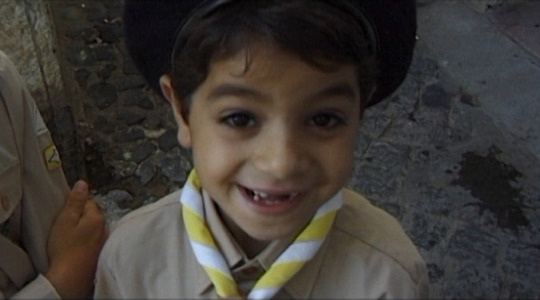
Jon Jost: 6 Easy Pieces (2000)
Jon Jost is one of cinema’s true independents, insisting on living and working authentically regardless of the costs. And these have not been inconsiderable. An army brat born in 1943 who grew up in the U.S., Japan, Italy, and Germany, he was expelled from college in 1963 and later spent more than two years in jail for draft dodging. After prison, he helped form a leftist filmmaking collective and then moved on to making his own films. Long before Dogme 95, he was writing, photographing, directing, and editing highly personal shorts, features, documentaries, and an uncategorizable hybrid of the latter two using nonprofessional casts and absurdly small budgets (his 1977 feature Last Chants for a Slow Dance allegedly cost $3000). These works, which show a highly developed sensibility in total command of the formal elements of filmmaking, are rarely screened outside museums and universities, the only exception being All The Vermeers in New York (1991), which played a few theatrical dates and on PBS.
Historically, Jost has used his films as platforms to assail America’s murderous middlebrow culture, taking on everything from the violence in the family and interpersonal relationships to money worship and consumerism to the brutalities of the country’s ruling elites. Jost doesn’t make his critique easy for audiences to decipher or accept. Bell Diamond (1986) is typical, presenting a disintegrating relationship by foregrounding an unwatched TV blaring away while the ghostlike figures of the doomed couple move mysteriously, and only occasionally, in the background. As so often with Jost, the individual falls apart against a backdrop of social decline, as in Bell Diamond’s seemingly abandoned industrial landscapes. There’s also a strange combination of ego and self-criticism in films like the “essay-fiction” Speaking Directly (1973), which shows him being reviled by a girlfriend, then talking about his penis, then masturbating in close-up for some minutes. Not exactly the stuff of PBS, or even the Sundance Film Channel. Since 1993, Jost has lived in exile in Europe; since 1997 he’s worked exclusively in the dream format of the impoverished auteur, digital video.
It’s a little surprising, then to see Jost’s late work drawing on his technical brilliance and poetic imagination, with the provocateur/polemicist receding into the distance. 6 Easy Pieces shows increasing evidence of the director preoccupied with the timeless rather than the timely. Even the title is playful, a witty (and typically misleading) reference to Bob Rafelson’s classic counterculture film. 6 Easy Pieces was shot in Portugal and Italy from 1997 to 1995, according to the endnote, “using Sony DX700 and 1000 cameras and edited on a PC using Premiere 5.1 editing software,” and “released” (presumably meaning copyrighted) in 2000. Despite the technospeak, and indeed the sophisticated visual manipulations, this is an emotionally charged work that derives much of its power from its sense of discovery, whimsy, and an awareness of the indifference of the universe to the individual.
Jost’s “brave new world” appears in the first sequence, a nighttime drive through “the justly fabled fogs of the Venetto.” Here the legerdemain of the digital is employed to make a simple driving trip both an abstraction, by fuzzing the image into a kind of pointillism, and palpable, a painting in motion. Writer Edoardo Albinati’s text, subtitled in English, evokes what Jost shows as a kind of cosmic construction whose beauty will outlast the human presence: “Edifices arising as crystal, erupting as extravagant growths, excreted as stalagmites from the thin ethers of mind and spirit…”
This compelling blend of the concrete and the abstract pervades the film, most effectively in the simplest sequence: images of water in a Venice canal with Jost’s voice in the background. The effect of the shimmering water is heightened by digital manipulations, which make it hypnotic as the patterns shift, stop, and start, lulling the viewer into a feeling of peace, even transcendence while Jost carps in voiceover about the Venice Biennale. The triumph of nature over the filmmaker’s petty complaints is a major thread here, and evidence of Jost’s increasing maturity as an artist. Water is also the ruling element in a lovely sequence in which two young women, mostly unseen, talk about their plans and their lives while swimming.
One of the most startling sequences features a split screen. On the right is a woman methodically loading and discharging a rifle. On the left is that dreaded creature, a mime, this one naked no less, and like so many mimes these days, actually talking, though mostly in grunts and monosyllables. Jost brilliantly mixes the menacing with the sardonic as the mime multiplies into several images, gesturing, dancing, and muttering inscrutable phrases like “fall … a sadness … an absence … an improbability…” The contrast between the sharpshooter’s rigid silence and methodical, compulsive behavior and the mime’s garrulous self-expression makes this a riveting dance between characters occupying different cinematic spaces but the same screen. 6 Easy Pieces shows Jost at his most exciting as both the mime and the sharpshooter, the artist and the technician, occupying different cinematic spaces but the same screen.
Bright Lights
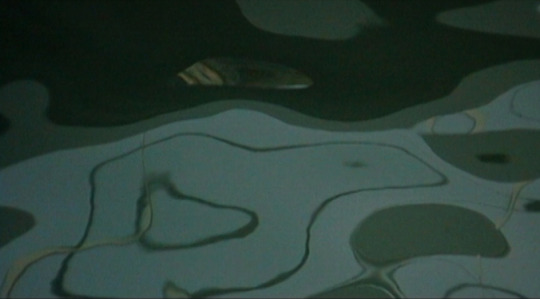
“Jon Jost takes us to the border of what film can be. It’s an open project that doesn’t attempt to make any statement, but stresses its materials as a composer would his music, using space, color, time. The filmmaker insists that his “electronic cinema” is a return to an authentic way of seeing. We took his word that his material is documentary, i.e. taken from reality, not dramatic or loaded with meaning. It makes us share in his pleasure at seeing, and captures moments of life that never took a sense before.”
Jury statement, Yamagata fest, for Runner up award, written by Hartmut Bitomsky, Jury President
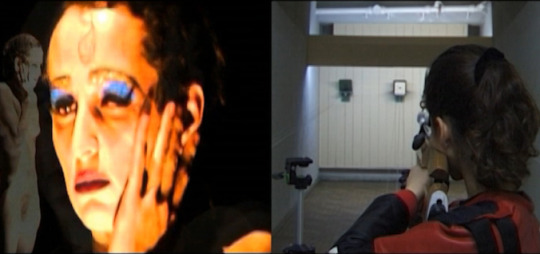
https://vimeo.com/ondemand/123735
Not So Easy Easy Pieces 6 Easy Pieces is a compilation of shots and sequences made over the period 1996 - 1999, which seemed to find themselves draw together by a kind of gravitational attraction.
0 notes
Note
Do you think that Rose and Kanaya were originally going to be moirails, and that their being girlfriends was OOC and detrimental to their characters? Generally, what do you think of rosemary?
Well, it’s @rosemarymonth and I’ve wanted to talk about Rosemary and why I think the canon gets WAY too little credit with regards to their execution for ages so I may as well do it now.
Keep in mind, of course, that I am a dude and in no way want any wlw to feel I’m shutting down critiques of Homestuck’s flaws in this regard. I think that’s perfectly valid, this is just my reading. I’ll be interested in seeing what people have to say.
I don’t get to talk about Rosemary enough anyway, so I’ll also take you up on it and go over why I love Rosemary and why I think readings that they were “meant to be moirails” and “go ooc” is straight up just misreading the text, because the comic is actually pretty clear in broadcasting its intent.
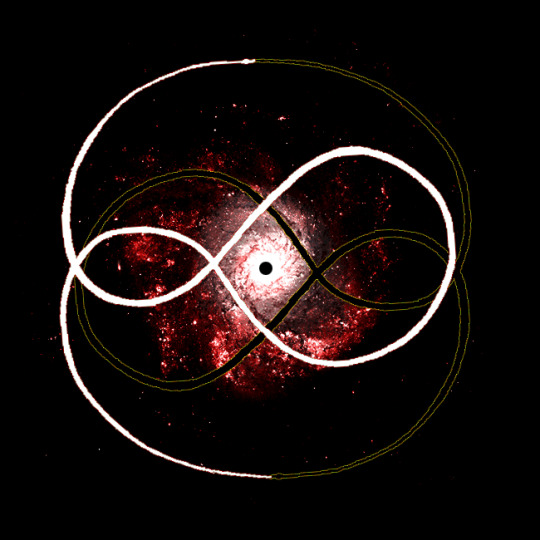
The thing to keep in mind is that Homestuck’s entire plot follows one consistent rule: The message of AURYN from The Neverending Story, “Do what you will.”
The events in Homestuck that actually happen are by design the sum product of the wills of the entire cast, and how well characters express their wills on reality directly correlates to how “powerful” they are.
Caliborn is the villain because Lord English violates EVERYONE’s agency by confining them all to the plot of Homestuck/his Alpha Timeline. Within the confines of those prescribed paths, however, reality always defaults to fulfilling the wishes of all characters involved, or resolving the tension between them.
What this means PRACTICALLY is that almost every event that happens in the story, no matter how ridiculous….

is, on some level, foreshadowed by the desires of the characters, just as Arquius’ heroic sacrifice and absorption into LE is foreshadowed by the desires of both him and Caliborn:
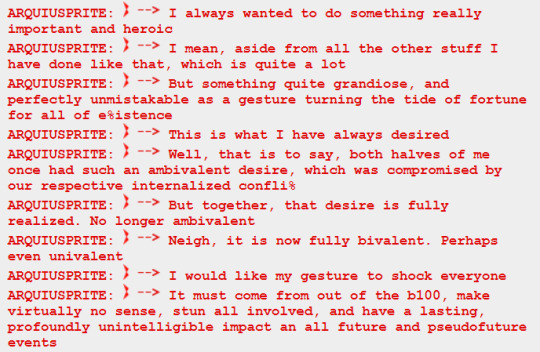

Oh, and speaking about Caliborn wanting to be bros with Dirk and allowing him to die as if going to sleep:

All this in mind, let’s focus on Rose and Kanaya. No, I don’t get the impression they were ever going to be moirails. I’m not sure when Hussie decided on Rosemary, but I get the impression it was early, at least by the time Kanaya was introduced.
Why? Let’s take stock of both girls’ desires and conflicts throughout Act 5.

Kanaya’s early characterization revolved around A) A tendency to gravitate and pacify take-charge, forward individuals,

and B) A profound dissatisfaction with that role.
That’s what burned her out so hard when she was interested in Vriska. So I’m not sure why one would assume that actually, Kanaya’s True Destiny was to fall into… the exact same arrangement with Rose once again, despite expressly avoiding it. That doesn’t seem like good storytelling to me.

Especially since Rose is, from the very beginning, posited as an idealistic escape from that solitude for Kanaya. Kanaya is the receiver of Rose’s prophetic text—one of her earliest big contributions as a Seer of Light– and it makes a tremendous impact on her.
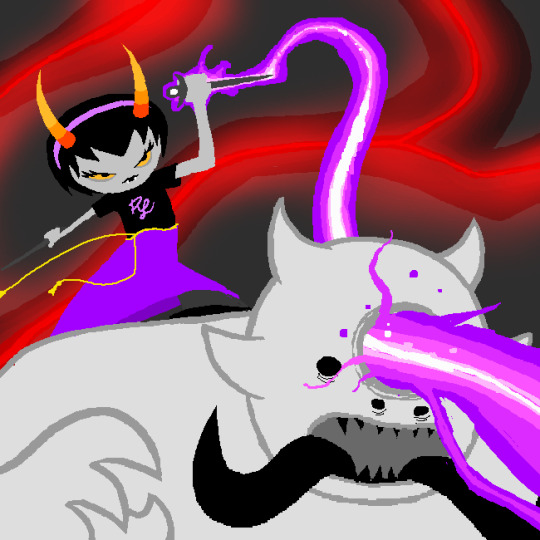
That impact is partly manifested as an out and out romantic fantasy about Rose, who Kanaya idealizes as the legendary leader of her session.
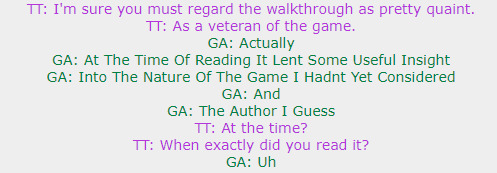

Kanaya’s fantasies about Rose in this regard play heavily into her attempted courtship through the Flighty Broads and their Snarky Horseshitometer sequence—and it is romantic courtship.
Kanaya makes that clear in the mission-critical text document where she positions herself as an antagonistic suitor to John, and that document is first referenced in… oh, mid-Act 4.
So Kanaya’s romantic interest suffuses the narrative from pretty early on. What about Rose?
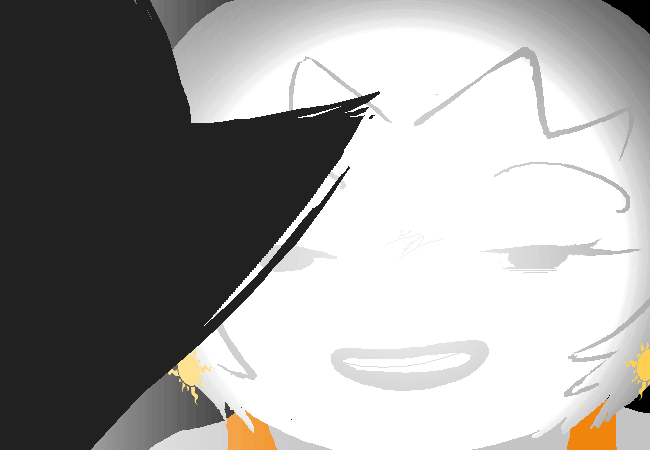
Let’s talk about romance aesthetics. Pretty much every endgame ship in Homestuck is couched in a distinctive brand of romantic connotation. For example, Dave and Karkat are linked to anime romance cliches, with Dave as shonen hero and Karkat as heroine.
Jade and Davepeta are linked by a mutual indulgence in furry identity. Vriska and Terezi get the “Home Sweet Home” connotation of The Wizard of Oz, and Dirk and Jake have the undying devotion and mutual passion implied by their link to The Princess Bride.

Rose is once described as a reserved girl “enamored by what dwelt in shadow”. This is a facet of her characterization that’s present from moment 1, what with her interest in the Horrorterrors. Another obvious place to go is Mom, and by association Roxy–both of whom certainly “dwell in shadow” as Void players.
And then, of course, we have Kanaya:
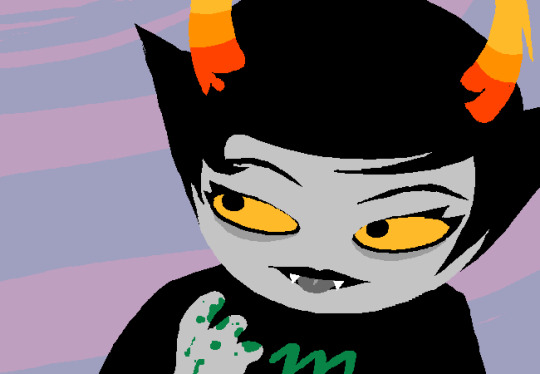

Vampires are traditionally associated with hiding in darkness, away from the Light. And Kanaya describes her rainbow drinker fantasy in exactly those terms. So this aesthetic link between them is established pretty damn early, too.
Of course, Kanaya is not a traditional vampire. I’m far from the first to point out that Rainbow Drinkers most strongly resemble the hyper-romanticized, shine-in-the-light vampires of Twilight, one of the most popular romance series for teen girls of the 2000′s.
Taking that incredibly popular aesthetic and using it as a wrapper for the love story of two girls is instantly compelling. What’s genius is that this is a cocktail of imagery that has natural appeal for Rose as a person, because while it’s true that she’s interested in the darkness that surrounds her, it’s clear that Rose spends her narrative seeking the truth and the meaningful.
In other words, even when she’s enmeshed in darkness, what Rose wants is…

The Light. She may not have taken an interest in Meyer’s prose or Edward’s surly patriarchal authority, but all else being equal? Rose was all but made for a story with imagery like Twilight’s. That in and of itself would be evocative and romantic enough, but it goes deeper.
Because Rose’s relationship with Kanaya is deeply interwoven with her relationship to the reality of Homestuck, a conflict that Kanaya directly helps her solve. Perhaps fittingly, given that Kanaya is a Sylph implied to be “Made of Space”, and so innately linked to the Setting of the story through her Aspect.
This conflict between Rose and the Setting of Homestuck is, in my view, nothing less than the main thrust of Rose’s character arc, so it’ll take a little bit to unpack. Let’s dig in.
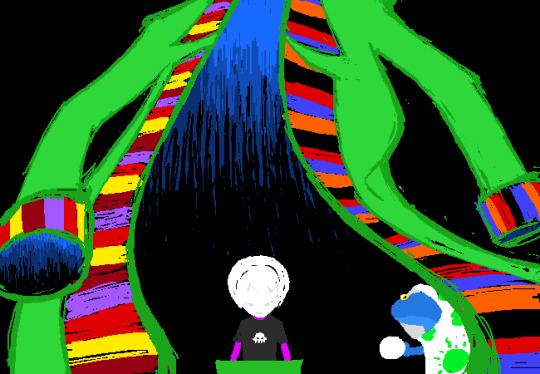
Rose gets too little credit. She is the first of the main cast to really learn about Lord English, and the unfathomable, canon-defining threat he poses to the cast.
But even before she learns about him in name, she spends pretty much her entire arc resisting and fighting against his machinations, subtly perceiving something deeply wrong in the story from its very beginning.
In this, Rose strikes a compelling counterpoint to her partner TT, Dirk Strider. Because If Dirk’s character arc revolves around his belief that he himself is inherently evil, then it’s fair to say Rose’s main conflict is a belief that the world itself is inherently evil.
Or at the very least, incomprehensible and meaningless. Random and empty of logic or reason. And borderline antagonistic to her and her friends, as though reality itself is an unfortunate occurence.
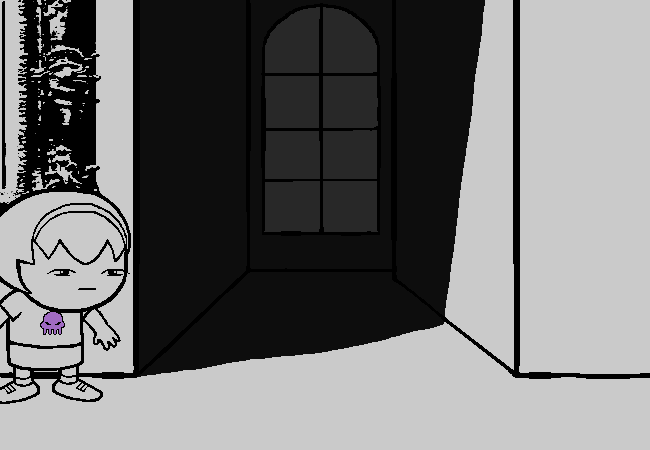
In other words, Rose’s experience of reality is deeply colored by Void, the aspect of the unimportant, meaningless, irrelevant, and most importantly: incomprehensible.
Just as Dave’s sense of self is broken by his abusive upbringing from a Prince of Heart, so too Rose’s sense of reality is shaped by her codependent relationship with her Mom, a guardian whose actions she can neither understand nor predict.
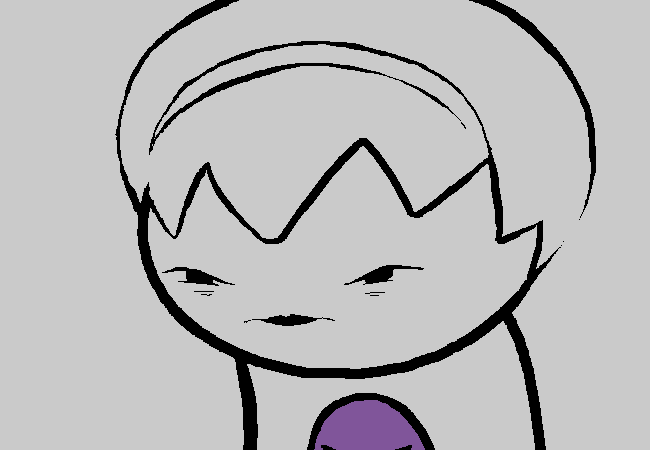


As a Seer of Light, Rose is drawn towards trying to understand the truth, and in particular the inner truths and meanings behind the minds of others. At the core of her being, Rose is a person who desperately desires to know and understand.
Consider how frustrating this must make Mom’s erratic and dysfunctional behavior to her–there’s no rhyme or reason behind her mother’s actions, influenced as they are by her depression, loneliness, and alcoholism. There’s just apparent randomness from the person who defines her entire life–in essence, the God of her household.
Add in Roxy’s tendency toward passive-aggressive behavior–which Rose definitely perceives from her Mom, whether it was intentionally directed at her or not–and it’s unsurprising that Rose quickly begins to view reality as not just nonsensical and arbitrary, but outright antagonistic.

Rose’s inherently defiant worldview is only intensified by Sburb. Not only does Mom continue being aloof and indecipherable, but Rose discovers that fate has apparently already decreed that she and her friends are doomed to failure and death. To Rose this is more than unacceptable: It’s infuriating.

Throughout Act 5, characters often comment on how Rose’s obsession with subverting Sburb leads her to becoming withdrawn, self-serious, and distant from her relationships. She also attempts to assume responsibility for herself and everyone around her, culminating in the suicide mission she tries to take on alone.
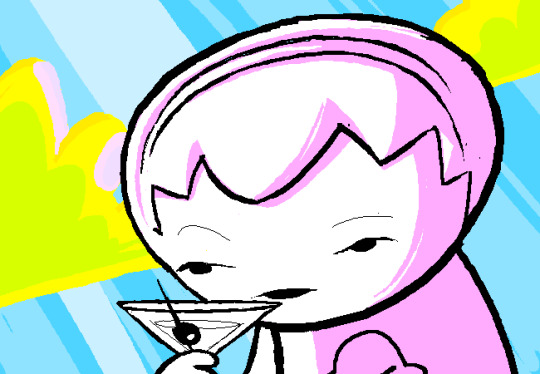

All of this is accompanied by her tearing her Land apart, as she foregoes its “childish” path in favor of something she perceives as more mature and adult. Most blatantly of all, Rose flirts with emulating her Mom in her most obviously adult activity: indulging alcohol. Rose is, in essence, trying to be an adult. Forcing herself to grow up too fast.
By the way? Withdrawing emotions, carefully managing the feelings of others, attempting to assume outsize responsibility for their households and attempting to take care of their guardians are all behavioral hallmarks of kids who grow up in codependent households.

Fast-forward to the aftermath of Cascade, when Rose achieves God Tier and comes face to face with Kanaya for the first time. It’s notable that achieving God Tier is the first moment that Rose is given any indication whatsoever that the plight she shared with her friends was not just random, pointless doom.
It is instead a lucky break. Or a suggestion of greater meaning. In essence, it’s the first time Rose is given really any reason to see reality as anything but the chaotic, nonsensical burden she’s experienced it as so far.
The revelation is accompanied by Kanaya’s sudden phosphorescence, which Rose describes as “inexplicable”–a word usually associated with frustration for her. Here, however, it comes as a happy surprise. Here, Rose is seeing through the incomprehensible Void of her reality to perceive Light for the first time.
I don’t think it’s a coincidence that the moment is paired with Rose’s first romantic overture toward Kanaya.

Especially since the trend continues. As Rose grows more confident reality not necessarily ALWAYS being a hellish, meaningless landscape of random and pointless suffering, she also grows more playful and willing to be sincere. She grows to trust the Light she was once so suspicious of, asks Kanaya out on dates, and comments on things she enjoys about her without insincerity.
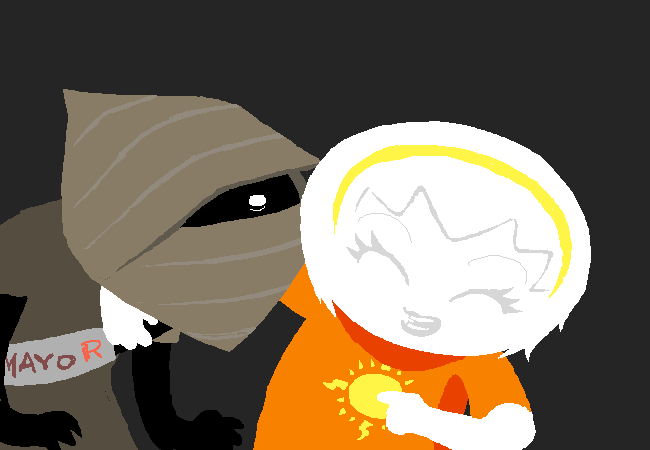


But she remains traumatized and conflicted about her relationship to both her Mom and the world, and takes up Mom’s alcoholism as a way to try to understand the former and ignore the latter.


This comes between her and Kanaya, since Kanaya relies on Rose to help her figure out HER role in the world, and to figure out how to achieve the revival of her species.
It’s worth mentioning that alcohol abuse, for both Rose and Roxy, is extremely Void-coded. It leads Rose to prioritize the pointless, ridiculous, unimportant and non-existent.
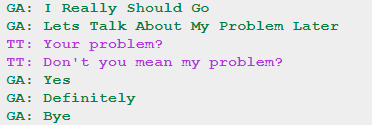
Void is also deeply tied to all things physical, as opposed to Light’s link to ideas and the imaginary. And Rose’s lack of guidance is a factor in making Kanaya succumb to her own addiction to Blood.
Here, Kanaya ends up valuing the desires of her physical form as a Rainbow Drinker over the more idealistic goal of the revival of her species, or even her relationship with Rose. As such, the two girls’ problems are marked as the same problem, even as they drive them further apart from one another.

And we see where their disunity and lack of direction takes them Pre-Retcon: It renders both of them less effective, and thus less important to the plot. It also leads them to misfortune. Rose’s inability to connect with and help, or even be helped by Kanaya, leads directly to tragedy in her relationship to the world.
Good thing there’s a flip side.

In the retcon timeline, Rose and Kanaya work stuff out. Rose gets past her alcohol addiction and directly credits Kanaya’s aid for it. Kanaya resists the pull of literal blood as she takes Karkat to Echidna and engages in an intellectual discussion about his relationship to his Aspect and the future of Troll-kind.
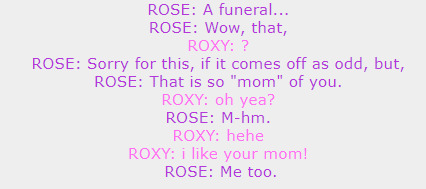
Rose reconciles with her Mom completely through Roxy, finding meaning where she could only speculate before. And with her increased ability to sort truth from lie, important from unimportant, and meaningful from irrelevant…

She resolves the tension between herself and the “demands” of Sburb, openly voicing her ambivalence to the very concept of her Personal Quest. In so doing, she illuminates an important truth to both the cast and the audience: that Sburb’s prescribed path to self-actualization is not particularly important, and certainly not strictly necessary.

Inner truth, understanding, good fortune, foresight, and happiness–Rose never needed to comply with some videogame’s 12-step program for self-satisfaction to get any of that, and neither do we. Light can arise anywhere, as long as you have the patience to look for it and people who love you at your side.
Hope this helps you see what I see, anon. Rose and Kanaya’s story is one worth cherishing, and I haven’t even come close to saying all I think there is to say about it, if you can believe that! But its a start.
Happy rosemary month, happy Halloween, and as always
Keep rising! ;)
[Patreon] [Hiveswap Discord]
#Rosemary#Rosemary month#Rose Lalonde#Kanaya Maryam#Homestuck#MSPA#My MSPA Analysis#Seer of Light#Anonymous#Sylph of Space#long post
457 notes
·
View notes